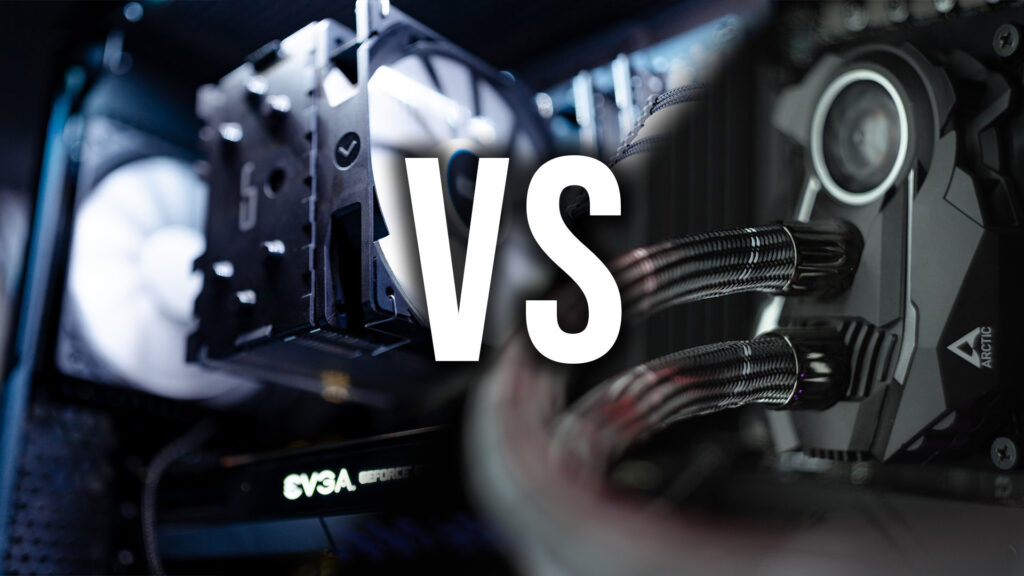
When it comes to keeping your computer cool and running optimally, there are two main options to consider: water cooling and air cooling. Both methods have their own advantages and disadvantages, so it’s important to understand the differences between them before making a decision. In this blog post, we’ll explore what water cooling and air cooling are, highlight their key differences, and provide tips for maintaining your chosen cooling solution. If the information from this article isnt’t enogh here is a guide to choosing the right CPU cooler.
Water Cooling
Water cooling, also known as liquid cooling, is a method of cooling computer components using a liquid coolant, typically water or a mixture of water and additives. This cooling solution involves a series of tubes, water blocks, radiators, pumps, and fans to dissipate heat from the components. The liquid coolant absorbs the heat and transports it away from the components, ensuring efficient cooling.
Water cooling offers several benefits over air cooling. Firstly, it provides superior heat dissipation, allowing for more efficient cooling of high-performance components such as CPUs and GPUs. This can result in lower temperatures and better overclocking potential. Additionally, water cooling tends to be quieter than air cooling, as the fans used in air cooling systems can generate more noise.
However, water cooling systems are generally more complex to install and require careful maintenance. They involve more components and tubing, and there is a risk of leaks if not properly installed or maintained. Water cooling also tends to be more expensive upfront compared to air cooling, as it requires the purchase of additional components.
Air Cooling
Air cooling, on the other hand, is the traditional method of cooling computer components using air. This cooling solution relies on a combination of fans and heatsinks to dissipate heat from the components. The fans blow cool air onto the heatsinks, which absorb the heat and transfer it away from the components.
Air cooling is generally simpler and more affordable than water cooling. It requires fewer components and is easier to install. Maintenance is also relatively straightforward, typically involving cleaning the fans and heatsinks to remove dust and debris.
However, air cooling may not be as efficient as water cooling, especially when it comes to cooling high-performance components under heavy loads. The temperature of the components can be higher compared to water cooling, which may affect performance or limit overclocking capabilities. Additionally, air cooling systems tend to generate more noise due to the fans spinning at higher speeds.
What to Keep in Mind
When deciding between water cooling and air cooling, there are a few factors to consider:
-
- Performance Needs: If you’re an enthusiast or a professional who requires maximum cooling performance for demanding tasks such as gaming or content creation, water cooling may be the better choice. It can handle higher heat loads and provide more efficient cooling.
-
- Budget: Water cooling systems are generally more expensive upfront due to the need for additional components. If budget is a concern, air cooling might be a more cost-effective option.
-
- Installation Complexity: Water cooling systems are more complex to install and require careful attention to ensure proper installation and prevent leaks. If you’re a beginner or prefer a simpler installation process, air cooling is a more straightforward option.
-
- Maintenance: Water cooling systems require regular maintenance to check for leaks, clean the components, and ensure optimal performance. Air cooling systems also require maintenance, but it’s generally less involved.
Tips for Maintaining Your Cooler
Regardless of whether you choose water cooling or air cooling, here are some general tips for maintaining your cooler:
-
- Clean regularly: Dust and debris can accumulate on fans and heatsinks, obstructing airflow and reducing cooling efficiency. Regularly clean your cooler to ensure proper airflow.
-
- Check for leaks: If you have a water cooling system, inspect the tubes and connections periodically for any signs of leaks. Address any leaks promptly to prevent damage to your components.
-
- Monitor temperatures: Keep an eye on the temperatures of your components using software monitoring tools. If you notice unusually high temperatures, it may indicate a problem with your cooling system.
-
- Replace thermal paste: Over time, the thermal paste between the CPU/GPU and the heatsink can degrade, leading to reduced cooling efficiency. Consider replacing the thermal paste every couple of years to maintain optimal performance.
Conclusion
In conclusion, both water cooling and air cooling have their pros and cons. Water cooling offers superior cooling performance and quieter operation but comes with a higher upfront cost and more complex installation and maintenance. On the other hand, air cooling is simpler, more affordable, and easier to maintain but may not provide the same level of cooling efficiency for high-performance components.
